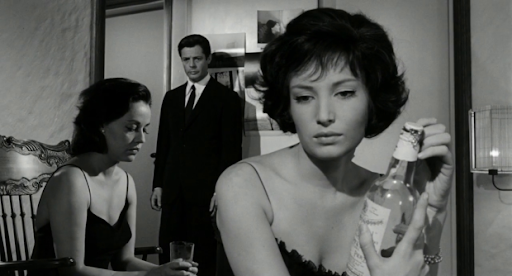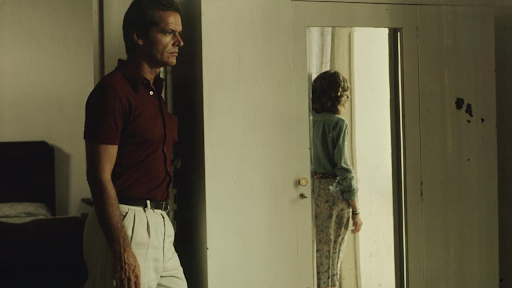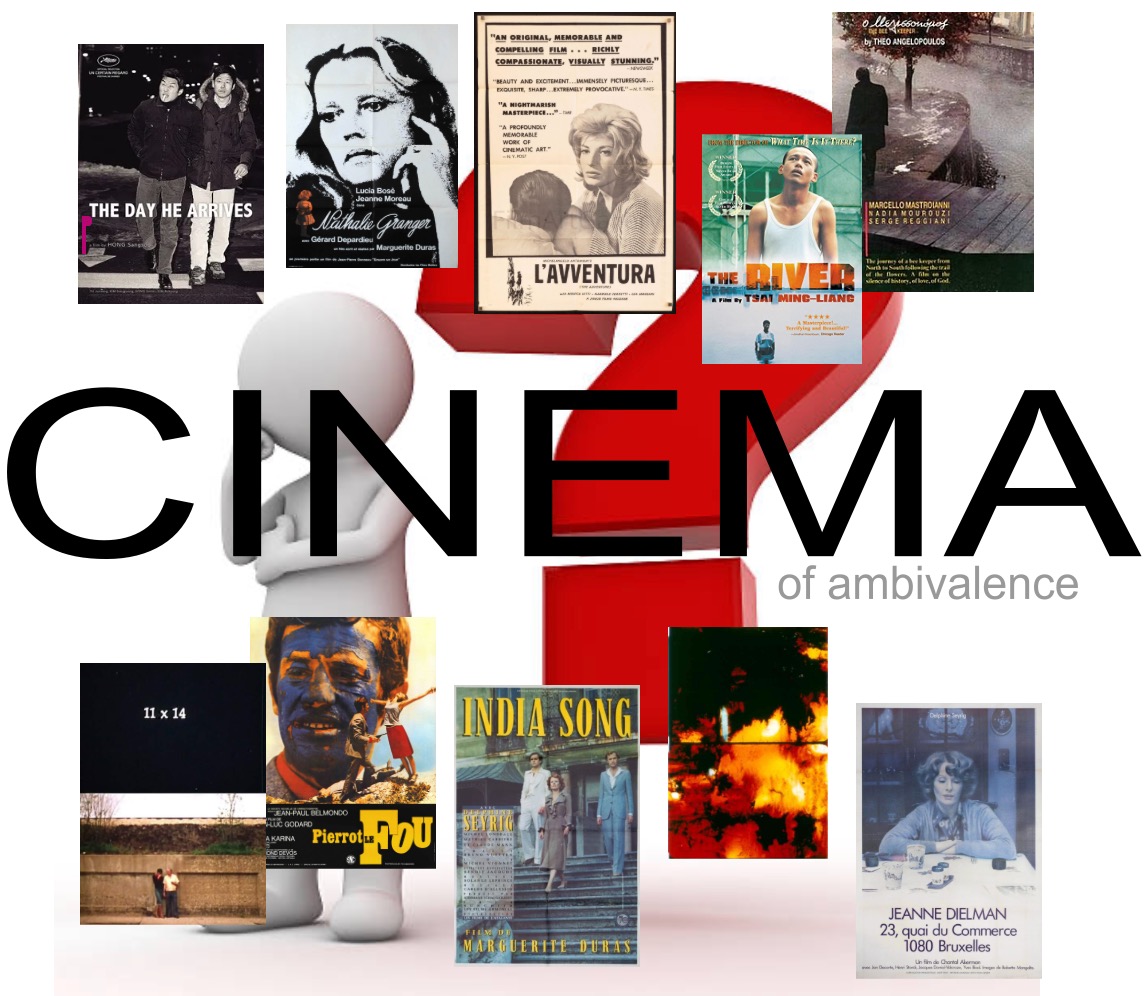The Cinema of Ambivalence
or: In Praise of Meandering
by Min Kim
André Bazin famously hypothesized that there are two kinds of filmmakers: ones that are concerned with the image and ones that are concerned with reality. The posterity of people like Eisenstein, Gance, or Murnau certified these two axes of filmmaking as the anchors of evaluating cinema, introducing a taxonomy as well as a tension. It’s a basic notion that that filmmaking is a process predicated on the struggle of that tension between the image and reality. Bazin is a strict advocate of the latter, but even he can’t sufficiently reckon with the fact that the very act of filmmaking is already tampering reality by capturing it in its artificial form. Likewise, the predicament of cinema may lie in that unlike any other medium, cinema is all movement but one that is merely a faux-movement, a string of still images presented in rapid succession before the audience. It’s not a photographic reality, but a latent reality met with an intervention of the camera whose kinetic actualization only manifests through the tension of what can or cannot be seen. In that way, Cinema is similar to reality itself because it’s an entity not simply riddled with tensions and contradictions but maintained by them, and its inherent inability to grasp reality’s elusiveness is what makes it a perfect clone of reality. For me, it is at its most compelling when within this friction germinate the aesthetic, formal, or narrative gestures that reveal a seeded nucleus of mystery.
A set of filmmakers have seemingly embraced this notion in their body of work - from Antonioni to Duras to Akerman to Angelopoulos to their more contemporary successors. Their films illuminate a reality whose vividness and power lie in the mystery that precedes, and supercedes, any conventional filmic explanation. In that manner, gaps, absences, uncertainties, and ambivalent movements become the central cinematic apparatus of these films. I have decided to call these films a cinema of ambivalence. This essay will examine the ways in which an eclectic group of filmmakers imagined and practiced this cinema of ambivalence, as well as how their lineage took shape with an evolving medium, leading to some contemporary practitioners.
The dictionary definition of ambivalence is “a simultaneous and contradictory attitudes or feelings (such as attraction and repulsion) toward an object, person, or action,” or “continual fluctuation (as between one thing and its opposite).” I myself would define ambivalence in cinema as “an expression of uncertainty linked to the abstraction or latensification of deeper feelings.” It is important to note that these films are not ambivalent, but rather they wish to suggest a sense of ambivalence ingrained in the nature of the image or reality they wish to capture. It is also important to note that ambivalence is not a style, but an intent, a goal. It seems arbitrary to call ambivalence an intent, but the intent here lies in the films’ control of their unfolding elements fated towards a friction with the audience, towards a dialectic. Ambivalence needn’t a set of salient rules to follow, for if it did, it wouldn’t be a potent expression of ambivalence any more. Any pre-established, solid mold would only serve to limit the films’ own individual mode of illuminating uncertainties.
The Blueprint: Michelangelo Antonioni
Deleuze posited that after WWII, “mature cinema” was no longer primarily concerned with telling stories to our conscious selves but now also sought to communicate with the unconscious; while the world recovered from a tragedy, cinema now called for an introspection, and the likes of De Sica, Ozu, and Rossellini were there to champion new ways of liaising introspection with the moving image. But their modes of introspection had mostly steered out of the realms of ambivalence and more towards realism or spiritualism. In 1960, it was Michelangelo Antonioni, with his Cannes-premiered L’Avventura, who successfully sensationalized such sentiment - not necessarily persuaded at first glance but inflamed an interest within the mainstream. It was Antonioni who forefronted the bulwark of narrative made of a nucleus of not certainty, but uncertainty, who conceived an image to embody a disappearance of things over appearance and assurance. Accordingly, the audience fiercely renounced the film in its early reception; for them, the most certain of all arts was cinema, as both a marker of motion, momentum, and meaning, as well as a rejection of stasis. Antonioni, who seemed only to be disempowering the medium, stood at a fork in the road - will he be a pioneer or a transgressor?

La Notte (1961, Antonioni)
In L’Avventura, there is a disappearance - as Anna, an aristocrat stricken by ennui, inexplicably disappears from her shallow rich friends - and then a disappearance of that disappearance - as Claudia and Sandro, her best friend and lover respectively, set out in search for her and start a love affair in the process, only to slowly forget that Anna was ever there in the first place. Anna’s disappearance brings about a rift in the most brutal fashion: the central perspective in the story vanishes without any apparent reason. We, the audience, parallel the loss of direction that the rest of the characters feel as, collectively, we are left aimlessly wandering the landscapes of apathy: vast swaths of space that are subject to their hidden, empty, and abstract qualities. The world of Antonioni is a world that seeks to strip its images down to the most obscure, evasive mysteries, a world where arbitrary fragments subsume every corner and obfuscate every horizon. This isn’t a matter of the simple dissolution of narrative, as anti-narratives were not a new concept; it is instead the dissolution of dramaturgy in the smallest unit of images. In the way, for instance, the aloof deep focus shots, used liberally throughout his early trilogy - L’Avventura, La Notte, L’Eclisse - consistently denote the sterility of people whose gazes and intentions are helplessly out of phase with each other. The way, under the clean, vapid brutalist architecture or the vast mysterious mountscape, lovers stand, unable to face each other, and we perceive something both violent and calm, eternal and inevitable, a quiet crushing of any chances at a resolution.
As such, the characters of Antonioni are in a constant state of disappearing, headed towards an inevitable end in which a radical stripping occurs. Locke in The Passenger is a man with no motive, goal, nor an inner life. He’s a filmmaker with no apparent burdens, until he inexplicably assumes the identity of a dead man he found in a hotel room next to his and becomes a voluntary fugitive, catering to a certain death drive that can only be fulfilled when he’s completely “gone,” non-existent, for no reason at all. The photographer in Blow-Up looks for an answer to a mystery that, the more he investigates and the more he enlarges the image, seems to direct him towards his own abstractions. When we finally pull the camera out far away, we discover that there was nothing here in the first place, not even the protagonist himself. They disappear, only to reveal the absence that was already there, and absence in Antonioni terms is a quality that can only be felt as a violence. Consider, for example, Sandro in L’Avventura. Just like the other players, Sandro’s background and motive is shrouded in mystery, obscure in a narrative where the context of facts lurks like a constantly receding horizon - dormant, abeyant. Then, an interesting disturbance occurs where Sandro, meandering alone, breezily knocks over a small bottle of paint onto an empty canvas he found. A small, paltry act of violence of which the source is undefined. Why did he knock over the bottle? Does he even know why? What kind of person is he? Does it matter? Then the question becomes - why did Antonioni show us this moment? He deemed it important, because it makes us ask these questions, for which the answers will be never revealed; it makes us pay our minds to the horizons of horizons, the black hole into which the visible reality vanishes. “I’ve always wanted,” Antonioni had said, “to make a mechanism not of facts, but of moments that recount the hidden tensions of those facts, as blossoms reveal the fact of the tree.” The resulting effect of ambivalence is a meaning that cannot be decoded except in the gathering undercurrents of feeling that have now precipitated it.

The Passenger (1975, Antonioni)
It may be true that the questions of inward uncertainty at the heart of Antonioni pictures are not necessarily new ones, that it may have been one of the prime impetuses of every art form, centuries prior to the emergence of cinema, to search for an answer to this very conflict. And yet, it is Antonioni who has suggested to cinema the expression of the unanswerable questions predicated in every existence, in the milieu of popular filmmaking no less. He has revealed that cinema is not an entity in opposition to reality, nor one that is better, but one that is pathologically synonymous, and devastatingly so. With the introduction of Antonioni, a cinema of ambivalence would ensue like an epiphany, forming a medium through which that hopeless reality can become entangled, finding its own language within.
END OF PART 1
